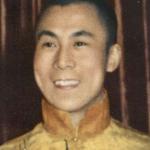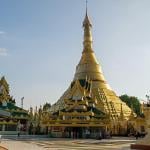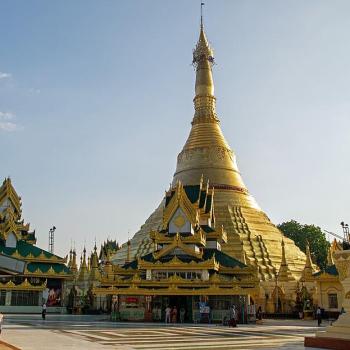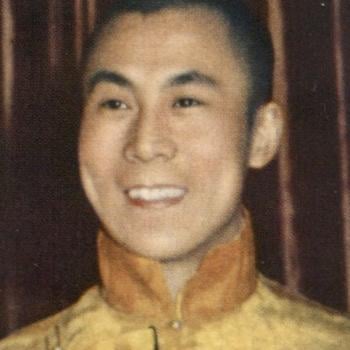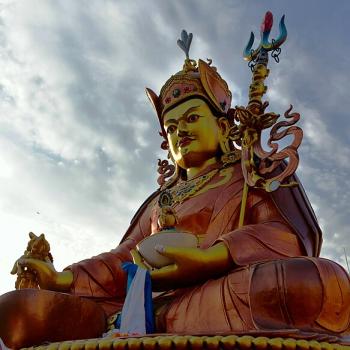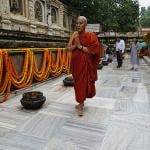Mahabodhi Temple — one of the world’s most sacred places — is now the site of a growing protest movement. Mahabodhi Temple is believed to mark the place where, about 26 centuries ago, the Buddha sat in meditation and realized enlightenment. Today the temple is claimed by both Buddhists and Hindus. Since 1949 the temple has been administered by a joint committee of Buddhists and Hindus, but this arrangement seems now to be entirely breaking down. The protests have not been violent, so far, but last month about two dozen Buddhist monks were removed from the temple by state police. And this galvanized a growing protest that is continuing as I write this.
Mahabodhi Temple is located in Bodh Gaya, in the state of Bihar, northeastern India. It’s believed the first temple on the site was built in the 3rd century BCE by the Emperor Ashoka. Ashoka was a patron of Buddhism who ruled most of what is now India and a great deal more from about 269 BCE to 232 BCE. That temple is gone, but I understand there are fragments of an Ashoka pillar at the site (see “The Mystery of the Pillars of Ashoka” for more about the pillars). The Vajrasana, or “diamond throne,” is also still there. This is a carved stone thought to have been placed by Ashoka on the very spot he believed the Buddha must have meditated. The current temple is a late-19th-century British renovation of the ruins of a temple that probably was erected in the 5th or 6th century CE.
According to several news sources, the Buddhist monks removed from the temple were engaged in a “relay” hunger strike. This means the members of the group were taking turns fasting, so that no one starved to death. They were demanding full control of the temple, but doing so peacefully. They objected to Hindu rituals that the Buddha had prohibited being performed in the temple. They also wanted Hindu symbols, such as representations of the deities Vishnu and Shiva, removed from the temple.
The Hindu Claim to Mahabodhi
Tradition tells us that the Buddha was born in Nepal and lived most of his life in what is now northeastern India (see also “Was There a Historical Buddha?“). Buddhism flourished in India for several centuries, then experienced a slow decline. In time there were only a few Buddhist monasteries left in the Indus Peninsula, although some of these were large and vibrant places of Buddhist learning, such as Nalanda. Late in the 12th century invading Turkic armies swept through India and destroyed Nalanda and the remaining monasteries. Most of the monks were slaughtered; most of the monastery buildings, including libraries and records, were burned. This effectively ended institutional Buddhism in India for the next several centuries.
It’s believed some monks may have lingered in Mahabodhi for a time, possibly as late as the 15th century. But then the place was abandoned. A Hindu monk, Ghamandi Giri, began living in whatever was left of Mahabodhi about 1590. He turned it into a Hindu monastery, and followers of Ghamandi Giri and their descendants continued to use the temple as theirs. The history and significance of the Mahabodhi Temple and Bodh Gaya were forgotten in India, but they were still remembered in other nations where Buddhism flourished.
Then came the British. Merchants began to arrive in India in the 17th century, and by the 18th century the British East India Company was a growing presence in India. From 1858 to 1947 India was incorporated into the British empire. Many of the British living in India became obsessed with fleshing out the history of the subcontinent, which at the time had many major gaps. The British and some other Europeans eventually pieced together Buddhism’s early development in India and located the ruins of sacred sites associated with the Buddha, including Bodh Gaya. In the 1880s the British colonial government of India decided to restore the Mahabodhi Temple, in response to complaints about its deplorable condition. For the story of how the British got involved in rebuilding the temple, see “The Mahabodhi Temple, Site of the Buddha’s Enlightenment.”
Whose Temple Is It Now?
The discovery and restoration of the Mahabodhi Temple caught the attention of Buddhists throughout Asia. One of these Buddhists was Anagarika Dharmapala (1864-1933) of Sri Lanka, who played a critical role in bringing Buddhism to the West as well as reviving Buddhism in Asia. In 1891 Dharmapala made a pilgrimage to Bodh Gaya to see the newly restored temple. He was dismayed to find that the temple was entirely controlled by Hindus who believed the Buddha to be an avatar of the Hindu deity Vishnu. Together with Sir Edwin Arnold Dharmapala founded the Mahabodhi Society, in part to petition India to give control of the temple to Buddhists.
In 1903 the viceroy of India, George Curzon — also called Lord Curzon — attempted to negotiate a compromise between the Hindus and Buddhists, but he failed. Two years after India gained independence from British rule in 1947, the state of Bihar passed the Bodh Gaya Temple Act. This law transferred the temple’s management from the Hindus to an eight-member committee made up of Hindus and Buddhists. Today it’s a nine-member board made up of five Hindus (including the chair) and four Buddhists.
Mahabodhi Temple Protests Now
The joint-administration plan appears never to have worked smoothly. The political reality is that nearly 80 percent of the population of India is Hindu, while Buddhists make up about 0.7 percent of the population. And from the Hindu perspective, they’ve been completely generous in allowing Buddhists access to the temple. Still, the Buddhists don’t believe the Buddha to have been an avatar of Vishnu. They object to Vishnu being worshipped in the temple and object to Vedic rituals that the Buddha criticized being performed in the temple. And it hasn’t been forgotten that there are Hindu scriptures that condemn Buddhism.
The Vedic rituals appear to be the primary point of contention. Over the years Buddhists have complained to local, state and national authorities about them. In 2012 two monks filed a petition to the Supreme Court to repeal the Bodh Gaya Temple Act. That petition has been ignored. In recent months, Buddhist monks have again submitted petitions to various government entities and engaged in street rallies. Then in February 2025 more than two dozen monks began their relay hunger strike in the temple. After 14 days police forcibly removed them.
The removal of the monks brought more Buddhists from around India to protest. Buddhists have also held protest rallies in their own communities. They hope to call the attention of Buddhists worldwide to the situation. Most observers doubt there will be any sort of resolution anytime soon, however. See also Protests Intensify for Buddhist Control of Mahabodhi Temple In Bodh Gaya by Justin Whitaker.



